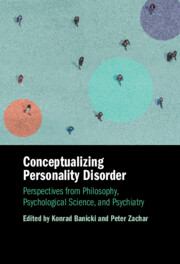 Conceptualizing Personality Disorder
Conceptualizing Personality Disorder Book contents
- Conceptualizing Personality Disorder
- Conceptualizing Personality Disorder
- Copyright page
- Contents
- Figures
- Tables
- Contributors
- Introduction
- Part I Historical Perspectives
- Part II Contemporary Approaches to Traditional Conceptual Perspectives
- Part III Novel Conceptual Approaches to Personality Disorder
- 10 What Does Personality Have to Do with Mental Disorder?
- 11 Self-Illness Ambiguity in Personality Disorders
- 12 On Personality Dimensions and Disorders
- 13 A Dual-Aspect Approach to Personality Disorder
- 14 Network Architectures of Personality and Its Pathology
- 15 From Paul Tillich’s The Courage to Be to Radical Acceptance and Radical Openness
- 16 Personality “Disorder” and the Incapacity to Self-Regulate
- Part IV Exploring Negative Consequences of Diagnosing Personality Disorder
- Part V Perspectives on Borderline and Narcissistic Personality
- Index
- References
11 - Self-Illness Ambiguity in Personality Disorders
Is It Me or My Disorder (that Makes Me Do X)?
from Part III - Novel Conceptual Approaches to Personality Disorder
Published online by Cambridge University Press: 25 June 2025
- Conceptualizing Personality Disorder
- Conceptualizing Personality Disorder
- Copyright page
- Contents
- Figures
- Tables
- Contributors
- Introduction
- Part I Historical Perspectives
- Part II Contemporary Approaches to Traditional Conceptual Perspectives
- Part III Novel Conceptual Approaches to Personality Disorder
- 10 What Does Personality Have to Do with Mental Disorder?
- 11 Self-Illness Ambiguity in Personality Disorders
- 12 On Personality Dimensions and Disorders
- 13 A Dual-Aspect Approach to Personality Disorder
- 14 Network Architectures of Personality and Its Pathology
- 15 From Paul Tillich’s The Courage to Be to Radical Acceptance and Radical Openness
- 16 Personality “Disorder” and the Incapacity to Self-Regulate
- Part IV Exploring Negative Consequences of Diagnosing Personality Disorder
- Part V Perspectives on Borderline and Narcissistic Personality
- Index
- References
Summary
This chapter provides an explorative analysis of self-illness ambiguity in personality disorders. Self-illness ambiguity refers to the difficulty in distinguishing one’s self from a mental disorder or diagnosis. Personality disorder diagnoses may invoke a specific type of self-illness ambiguity, for the characteristics of personality disorders (i.e., maladaptive personality traits) seem more closely related to “who one is” than to a disorder. Our analysis focuses on the concept of trait maladaptivity. We use three characteristics of trait maladaptiveness (temporality, severity, and attitude) to compare such maladaptivity in personality disorders with other cases of trait maladaptivity. Aside from some similarities, we argue that managing one’s traits in the context of personality disorders is distinct in that it may involve a distancing or disidentification with the maladaptive trait, which sometimes leads to the development of a subsidiary (or “as if”) self. In a further step, people with a personality disorder may start to experience what we call “self–self-ambiguity,” where they struggle to determine whether a particular action is part of their default or subsidiary self. Finally, we discuss how people with a personality disorder implicitly relate to their maladaptive personality traits using the concept of self-relating.
Keywords
Information
- Type
- Chapter
- Information
- Conceptualizing Personality DisorderPerspectives from Philosophy, Psychological Science, and Psychiatry, pp. 196 - 214Publisher: Cambridge University PressPrint publication year: 2025